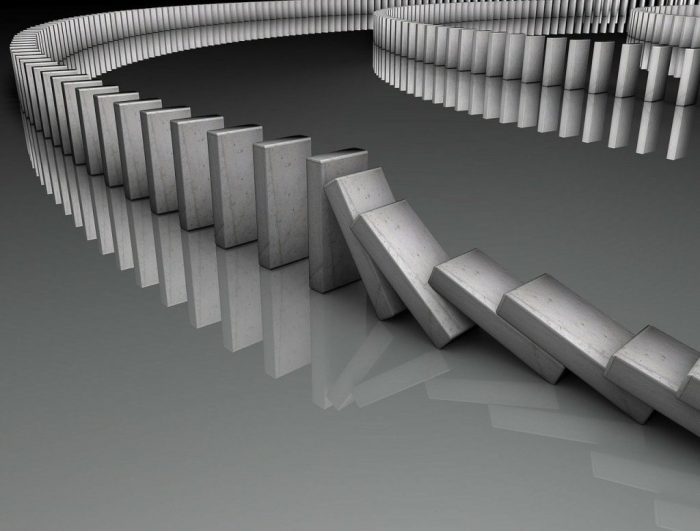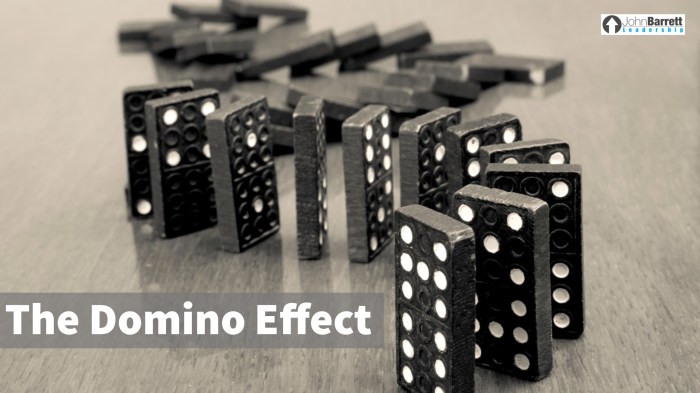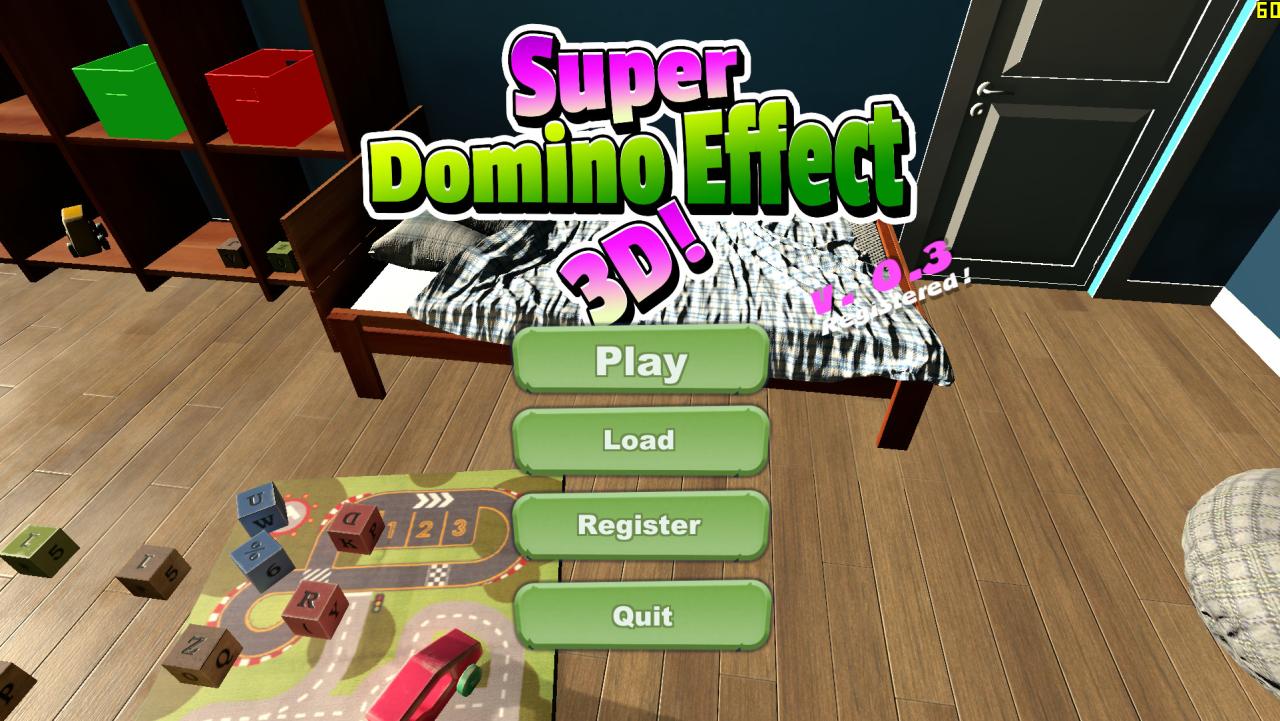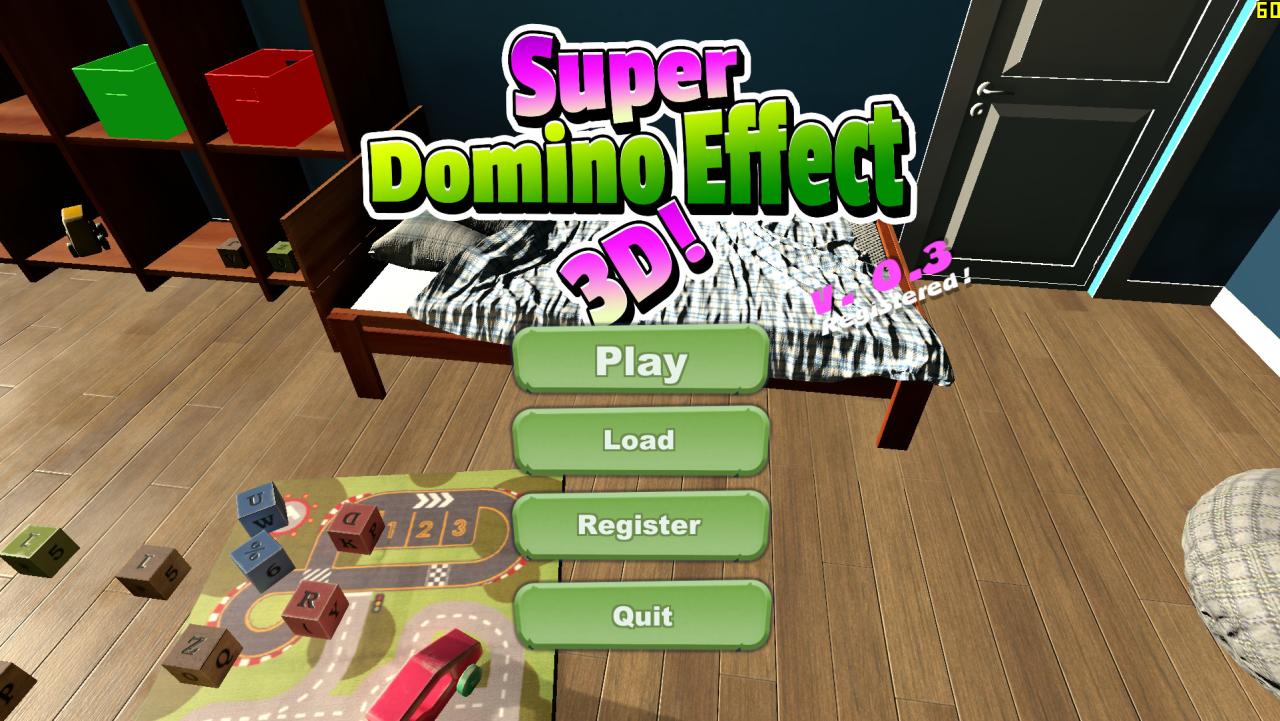Picture this: a single domino topples, setting off a chain reaction that brings down a whole line of its brethren. It’s a simple, mesmerizing spectacle, but the domino effect goes far beyond the realm of physics. It’s a metaphor for how seemingly small actions can ripple outwards, causing massive consequences in the world around us.
From the way we interact with each other to the forces that shape history, the domino effect is a powerful force that’s constantly at play.
This article dives deep into the domino effect, exploring its roots in the world of physics, its influence on human systems, and its presence in art and literature. We’ll unravel the secrets behind this fascinating phenomenon, revealing how it can both inspire awe and spark fear.
The Physics of the Domino Effect

The domino effect is a captivating phenomenon that showcases the power of chain reactions. It’s a simple yet profound illustration of how a small initial action can trigger a cascade of events, ultimately leading to a much larger outcome. At the heart of this mesmerizing display lies the fundamental principle of momentum transfer.
Momentum Transfer in the Domino Effect
The domino effect is a prime example of how momentum, a measure of an object’s mass in motion, can be transferred from one object to another. When a domino is pushed, it gains momentum and transfers this momentum to the next domino in line upon collision.
This transfer of momentum causes the second domino to topple, which in turn transfers momentum to the third domino, and so on. The domino effect is a visual representation of this ongoing transfer of momentum, creating a captivating chain reaction.
Factors Influencing the Domino Effect
Several factors influence the speed and force of the dominoes falling, making the domino effect a fascinating subject to explore.
Domino Size and Weight
Larger and heavier dominoes possess greater inertia, making them more resistant to changes in motion. This means they require more energy to start falling and, once they fall, they have greater momentum to transfer to the next domino. Consequently, a chain reaction with larger and heavier dominoes will be more forceful and less prone to stopping.
Spacing Between Dominoes
The spacing between dominoes plays a crucial role in determining the speed and efficiency of the chain reaction. Closely spaced dominoes will transfer momentum more efficiently, resulting in a faster and more consistent domino effect. Conversely, widely spaced dominoes require greater energy to initiate the chain reaction and may lead to a less predictable and potentially interrupted cascade.
Material of the Dominoes
The material of the dominoes affects their stability, friction, and resilience, which influence the speed and force of the domino effect. Dominoes made from materials with lower friction coefficients, such as polished wood or smooth plastic, will fall more easily and smoothly, contributing to a faster and more consistent chain reaction.
Real-World Examples of the Domino Effect
The domino effect is a fundamental concept that extends beyond the realm of toy dominoes. It serves as a powerful analogy for understanding various real-world phenomena, including chain reactions, cascading events, and feedback loops.
“The domino effect is a powerful metaphor for understanding how small changes can have large and unexpected consequences.”
Author Unknown
Chain Reactions
Chain reactions are a prime example of the domino effect. A classic example is a nuclear chain reaction, where the fission of one uranium atom releases neutrons that trigger the fission of other atoms, leading to a rapid and self-sustaining reaction.
Cascading Events
Cascading events, often seen in financial markets or social media, illustrate the domino effect’s impact. A small event, such as a stock market decline, can trigger a chain reaction, leading to a wider economic downturn. Similarly, a viral post on social media can lead to a cascade of reactions, resulting in a significant social or political impact.
Feedback Loops
Feedback loops, which are common in biological and technological systems, also demonstrate the domino effect. A positive feedback loop amplifies a change, leading to a snowball effect, while a negative feedback loop dampens a change, promoting stability.
You know how they say one thing leads to another? Like, you drop a domino, and it knocks over the next one, and then the next, and so on? That’s the domino effect, baby! And if you’re looking to level up your study game with some seriously cool vibes, check out this Composition Notebook Dark Academia Aesthetic College Ruled With Skull Cover Design.
It’s like, you’ll be so inspired by the aesthetic, you’ll be knocking out those notes like a boss! And before you know it, you’ll be crushing your exams, thanks to the domino effect of a killer notebook and a whole lot of dedication.
The Domino Effect in Human Systems

The domino effect, a simple concept in physics, takes on a profound significance when applied to human systems. It highlights the interconnectedness of individuals, institutions, and societies, revealing how small initial actions can cascade into far-reaching consequences.
Social Movements and Political Revolutions
The domino effect plays a crucial role in shaping the course of social movements and political revolutions. A spark, often ignited by a single event or individual, can set off a chain reaction, mobilizing individuals and galvanizing public opinion.
Think of the domino effect like a chain reaction, one small move sets off a cascade of events. That’s kinda like how learning to use a Cricut can become your new obsession! You’ll find yourself crafting up a storm, making everything from personalized gifts to party decor, all thanks to the awesome tips and tricks in Cricut The Most Complete Guide to Master Your Cricut Machine with 200+ Projects Ideas – Top Secret Tips and Tricks to Effortlessly Become Your Friends’ & Family’s Favorite Crafter!.
Before you know it, you’ll be the ultimate DIY queen or king, with a domino effect of awesome creations coming your way.
- The Arab Spring, a series of uprisings that swept across the Middle East and North Africa in 2010-2011, exemplifies this. The Tunisian Revolution, sparked by the self-immolation of Mohamed Bouazizi, served as a catalyst for protests across the region, ultimately leading to regime changes in Egypt, Libya, and Yemen.
- The 2011 Occupy Wall Street movement, while not resulting in immediate political change, had a profound impact on public discourse and the perception of economic inequality. It inspired similar protests around the world, highlighting the power of grassroots movements in challenging the status quo.
Economic Crises
Economic crises are often characterized by a domino effect, where the failure of one institution or market can trigger a chain reaction of failures across the system.
- The 2008 financial crisis, triggered by the collapse of the US housing market, exemplifies this phenomenon. The failure of Lehman Brothers, a major investment bank, sent shockwaves through the global financial system, leading to a cascade of bank failures, a global recession, and government bailouts.
- The Asian financial crisis of 1997-1998, which originated in Thailand, spread rapidly to other countries in Southeast Asia, ultimately affecting global markets. The crisis highlighted the interconnectedness of global economies and the potential for a domino effect to spread financial instability.
Technology and Culture
The domino effect is also evident in the rapid evolution of technology and culture. The introduction of a new technology can create a cascade of innovation and change, shaping the way we live, work, and interact with each other.
- The rise of the internet in the 1990s triggered a domino effect of technological advancements, leading to the development of e-commerce, social media, and mobile technologies. This, in turn, has transformed communication, commerce, and social interaction, creating new industries and opportunities.
- The widespread adoption of smartphones and mobile apps has created a domino effect in the entertainment industry. Streaming services like Netflix and Spotify have disrupted traditional media, leading to a shift in consumer habits and a decline in traditional television viewership.
The Domino Effect in Art and Literature

The domino effect, with its simple yet profound imagery of cascading consequences, has captivated artists and writers for centuries. It serves as a powerful metaphor for the interconnectedness of events, the ripple effects of choices, and the fragility of stability.
From literature to film and music, the domino effect finds its expression in various forms, adding depth and complexity to narratives and artistic creations.
The Domino Effect as a Metaphor in Literature
The domino effect has been a recurring theme in literature, often employed to illustrate the intricate web of cause and effect that governs human lives. Authors use this metaphor to explore the ripple effects of actions, both big and small, and how seemingly insignificant events can have far-reaching consequences.
- “The Butterfly Effect” in Literature:The butterfly effect, a concept in chaos theory, is a prime example of the domino effect in literature. It posits that even the smallest change in initial conditions can have drastic and unpredictable consequences in the long run.
Authors like Ray Bradbury in his short story “A Sound of Thunder” and Michael Crichton in his novel “Jurassic Park” utilize this concept to explore the dangers of tampering with the delicate balance of nature and the potential for unintended consequences.
- The Domino Effect in Historical Fiction:Historical fiction often employs the domino effect to illustrate the chain reactions that led to significant historical events. For instance, in Victor Hugo’s “Les Misérables,” the protagonist Jean Valjean’s initial act of stealing bread sets off a series of events that shape his life and the lives of those around him, ultimately culminating in the June Rebellion.
- The Domino Effect in Character Development:Authors use the domino effect to depict the impact of events on characters’ lives and choices. In William Faulkner’s “The Sound and the Fury,” the Compson family’s downfall is attributed to a series of unfortunate events, each triggered by the previous one, highlighting the destructive nature of the domino effect.
The Domino Effect in Film
The domino effect has been a popular motif in film, particularly in action and thriller genres, where it is often used to create suspense and highlight the consequences of characters’ actions. The visual nature of film allows filmmakers to visually represent the domino effect, making it more impactful and engaging for viewers.
You know how sometimes one little thing can set off a chain reaction, like a domino effect? Well, that’s exactly what happens in this story, and you can Download And Listen Here to find out what sets everything in motion.
It’s a wild ride that’ll leave you wondering what’s going to happen next, just like those dominoes tumbling down one after another.
- “The Usual Suspects” (1995):This neo-noir crime film employs the domino effect to depict the intricate web of lies and deceit that unravels the characters’ lives. The film’s narrative is structured around a series of events, each triggering the next, leading to a shocking revelation at the end.
- “The Matrix” (1999):This science fiction film utilizes the domino effect to illustrate the consequences of Neo’s choices. His decision to fight against the machines sets off a chain reaction that ultimately leads to the liberation of humanity.
- “The Butterfly Effect” (2004):This psychological thriller directly explores the concept of the butterfly effect. The protagonist has the ability to travel back in time and change events, but his actions often have unintended and devastating consequences, highlighting the unpredictable nature of the domino effect.
The Domino Effect in Music
Music, like other art forms, can convey the domino effect through various techniques. Musicians use repetition, rhythm, and dynamics to create a sense of cascading events and the interconnectedness of sounds.
You know how they say one thing leads to another? Like a domino effect, right? Well, that’s kind of how I stumbled upon this awesome picture book for adults with dementia. I was looking for something to help my grandma, and it’s totally perfect for her.
Anyway, that’s the domino effect for ya! One thing leads to another, and you end up finding something amazing.
- “Domino” by Jessie J (2011):This pop song uses the metaphor of dominoes falling to symbolize the impact of a relationship on a person’s life. The lyrics describe how a single event can set off a chain reaction of emotions and experiences.
- “The Domino Effect” by The Prodigy (1997):This electronic dance music track utilizes repetitive rhythms and layered sounds to create a sense of relentless momentum, evoking the unstoppable force of the domino effect.
- “Chain Reaction” by Diana Ross (1980):This disco song uses the metaphor of a chain reaction to describe the overwhelming power of love. The lyrics illustrate how one act of love can set off a chain of positive emotions and actions.
The Psychological and Emotional Implications of the Domino Effect in Storytelling and Artistic Expression
The domino effect holds significant psychological and emotional implications for storytelling and artistic expression. It evokes a sense of inevitability, reminding us that our actions have consequences, both intended and unintended.
- Fear and Anxiety:The domino effect can create a sense of fear and anxiety in viewers or readers, as they witness the potential for disaster or tragedy stemming from seemingly insignificant events. This is often used to heighten suspense and keep audiences on the edge of their seats.
- Hope and Redemption:Conversely, the domino effect can also inspire hope and redemption. By depicting how small acts of kindness or courage can set off a chain reaction of positive change, artists can offer a message of optimism and the possibility of overcoming adversity.
- Empathy and Understanding:The domino effect can foster empathy and understanding by highlighting the interconnectedness of human lives. By illustrating how the actions of one individual can impact the lives of others, artists can encourage viewers and readers to consider the broader consequences of their own choices.
Wrap-Up

The domino effect is a reminder that everything is connected. It’s a powerful force that can be harnessed for good or lead to unexpected consequences. Whether it’s a social movement gaining momentum, a technological innovation spreading like wildfire, or a creative masterpiece capturing the imagination, the domino effect is a constant in our lives.
Understanding its mechanisms can help us navigate the complexities of the world and make informed decisions that shape our future.
User Queries
What is the difference between the domino effect and a chain reaction?
The domino effect is a specific type of chain reaction where objects fall in a sequential manner, transferring momentum from one to the next. Chain reactions, however, can involve a wider range of processes and don’t necessarily require physical objects to fall.
How does the domino effect apply to social media?
The domino effect is a powerful force on social media. A viral video, a trending hashtag, or a controversial post can quickly spread, leading to widespread impact and even influencing real-world events.
Can the domino effect be reversed?
In some cases, the domino effect can be reversed. For example, interventions or countermeasures can be implemented to stop the spread of a negative event or to mitigate its impact.

